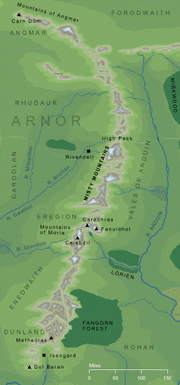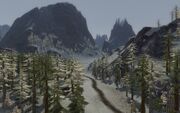Template:Semi-protected
Misty Mountains as seen in the prologue of the Fellowship of the Ring film
The Misty Mountains, also named the Hithaeglir [Sindarin; hîth (mist) + aeglir (range of mountain peaks)], was a mountain range that ran 1280 kilometres (795.35 miles) from north to south between Eriador and the valley of the Great River, Anduin, and from Mount Gundabad in the far north to Methedras in the south.
An early version of this range's name was Ered Hithui [Sindarin; ered (mountains) + hithui (misty)].
Geographical description

Misty Mountains on a map showing density of Forests and grasslands.
The range's notable peaks were Caradhras, Celebdil, Fanuidhol, Mount Gundabad, and Methedras.
Location
The northernmost peak of the Misty Mountains was Mount Gundabad; where according to legend Durin (eldest of the Seven Fathers of the Dwarves) awoke, though it became an abode and mountain-fortress of Orcs.
The greatest Dwarven realm in Middle-Earth, Khazad-dûm (later named Moria), was located at the midpoint of the Misty Mountains. The three peaks that were part of Khazad-dûm were Caradhras (Redhorn), Celebdil (Silvertine) and Fanuidhol (Cloudyhead). Inside Celebdil, the Dwarves built the Endless Stair, from the foundations of the mountain to the top of it. The southernmost peak of the Misty Mountains was Methedras, meaning "the Last Peak".[1]
Routes through the Misty Mountains
The most important passes were the High Pass and the Redhorn Pass. There was also a pass at the source of the Gladden river.[1]
Routes around the Misty Mountains
The Gap of Rohan was the valley (probably of the River Isen) between the southernmost peaks of the Misty Mountains and the northernmost of the White Mountains. There may have been a gap between Mount Gundabad in the Misty Mountains and the westernmost extremity of the Grey Mountains, though published maps differ on this point.[1]

Misty Mountains, northeast of Rivendell The Lord of the Rings Online
Inhabitants
Under the Misty Mountains were the former Dwarf realm of Khazad-dum, and the "Goblin-town" in which Bilbo Baggins stumbled across the One Ring, which had been in the possession of the creature Gollum, who also dwelt there himself on the eastern side. Rivendell was hidden in the foothills of the Misty Mountains at the western end of the High Pass.
Carn Dûm, where the Witch-King of Angmar resided for several centuries in the Third Age, lay between a western spur of the northern extreme of the range, known as the Mountains of Angmar. Mount Gundabad, the largest Goblin dwelling in the Misty Mountains, was located south-east of Angmar.
Isengard lay centered around the Tower of Orthanc in Nan Curunír, the valley between the arms of Methedras, which was the southernmost peak of the Misty Mountains. The "stone-giants" also inhabited this mountain range, as told in The Hobbit.
History
Origins
The Misty Mountains were created by Melkor during the Time of the Trees, who wanted to make it difficult for Oromë, who often rode across Middle-earth hunting his fell beasts, to pass.
Years of the Trees
The Dwarves of Durin awoke under Mount Gundabad and later established the caves of Khazad-dûm. Later, when the Elves on their Great Journey to Valinor looked upon their terrible height a portion of the Teleri, later known as the Nandor grew afraid and turned south down the Great River. Thousands of years later, the Ñoldor returned to Middle-earth and established great realms in the Beleriand and in the highlands, but they never crossed the mountains or established realms within them.
First and Second Ages
Over three-hundred years into the First Age, the tribes of Men crossed the Misty Mountains and began migrating into the Beleriand, first the Edain and then later the Easterlings or Swarthy Men. After the defeat of Morgoth, the surviving orcs and a Balrog came to live there and would remain a problem for over six-thousand years. The Easterling men who fought with Morgoth crossed the mountains and began living east of the Wilderland in Rhûn. The Great Eagles also began living here in a place known as the Eagles Eyrie.
The great Dwarven realm of Khazad-dûm beneath the Misty Mountains thrived as good relations with the Ñoldor of Eregion were established, until Sauron invaded Eriador from Mordor and the east destroying Eregion and ravaging the lands beyond. The dwarves survived by shutting themselves in Khazad-dûm behind the Doors of Durin.[2]
Third Age
In TA 1980, the great Dwarven realm of Khazad-dûm came to an end when the Dwarves unearthed a Balrog which led to its desertion by TA 1981, after which it was known as Moria (literally, "black chasm"). Slowly, the Misty Mountains became increasingly perilous and dangerous to travelers as Goblins and other creatures came to dwell under there.
Almost a thousand years later, the thirteen Dwarves, Gandalf, and Bilbo Baggins used the High Pass to cross the Misty Mountains during the Quest for the Lonely Mountain, and were captured by Goblins whilst crossing. Under the mountains, the Great Goblin was slain, and Bilbo found the One Ring.
The Fellowship of the Ring tried to cross the Redhorn Pass (after rejecting the High Pass leading to Rhovanion as being watched by the Enemy, and the Gap of Rohan as taking the Fellowship too close to Isengard), but a blizzard forced it to go under the mountain instead of over it. They faced a Balrog that dwelt in the deserted realm of Khazad-dûm. Gandalf slew the Balrog by casting it down from Zirakzigil, but it had worn his life already, and on that high ground he lay until Gwaihir bore him to Lothlorien.[3]
Mentions in media and books
- Led Zeppelin recorded a song, Misty Mountain Hop, which seems to have borrowed the name but little else from Tolkien. Several other Led Zeppelin songs contain Tolkien references, including "The Battle of Evermore" and "Ramble On".
- Robert Jordan's fantasy series The Wheel of Time also features a mountain range called the Mountains of Mist.
- The Misty Montes on Titan, Saturn's largest moon, are named after their Tolkienesque equivalent. This is from an IAU convention that names mountain ranges on Titan after mountain ranges from Tolkien's work.
Translations around the World
| Foreign Language | Translated name |
|---|---|
| Afrikaans | Mistige Berge |
| Albanian | Malet e Mjegullt |
| Amharic | ጭጋግና ተራሮች |
| Arabic | جبال ضبابية |
| Azerbaijani | Dumanlı Dağları |
| Basque | Lausotu Mendiak |
| Belarusian Cyrillic | туманныя горы |
| Bengali | কুয়াশাচ্ছন্ন পর্বতমালার |
| Bosnian | Magleno Gorje |
| Bulgarian Cyrillic | Мъгливите планини |
| Catalan | Muntanyes Ennuvolades |
| Cebuano | Gabonon Bukid ? |
| Chichewa | Kwankhungu Mapiri |
| Chinese (Hong Kong) | 迷霧山脈 |
| Croatian | Maglovita Brda |
| Czech | Mlžné Hory |
| Dari | مهدار ﻙوه ? |
| Estonian | Udune Mäed |
| Filipino | Malabo Bundok |
| Finnish | Sumuvuoret |
| French | Monts Brumeux |
| Frisian | Mistich Bergen |
| Danish | Tågede Bjerge |
| Dutch | Mistige Bergen |
| Galician | Montañas Enevoadas |
| Georgian | ნისლიანი მთები |
| German | Nebelgebirge |
| Greek | ομιχλώδη βουνά |
| Gujarati | ઝાકળવાળું પર્વતો |
| Hindi | मिस्टी पहाड़ों |
| Hungarian | Köd-hegység |
| Irish Gaelic | Sléibhte Ceo ? |
| Italian | Montagne Nebbiose |
| Indonesian | Pegunungan Berkabut |
| Japanese | 霧ふり山脈 |
| Kannada | ಮಿಸ್ಟಿ ಪರ್ವತಗಳು |
| Kazakh Cyrillic | Містй Моұнтаінс |
| Korean | 안개 낀 산 ? |
| Kurdish | چياى تەم ومژاوى ? Çiyayên Moranê (Latin) |
| Kyrgyz Cyrillic | Мистй Моунтаинс ? |
| Latin | Nebulosa Montes |
| Latvian | Miglains Kalni |
| Lithuanian | Rūkas Kalnuose |
| Macedonian Cyrillic | магливиот планините |
| Malayalam | മഞ്ഞുമൂടിയ മലകളെ |
| Malagasy | Zavona Tendrombohitra |
| Malay | Gunung Berkabus |
| Maltese | ċpar Muntanji ? |
| Marathi | अंधुक पर्वत |
| Manx | Sleityn Fo-chay ? |
| Mongolian Cyrillic | хандаасай уулс |
| Nepalese | कुइरो लागेको पर्वतहरू |
| Norwegian | Tåkefjellene |
| Polish | Góry Mgliste |
| Portuguese (Brazil) | Montanhas Sombrias or Montanhas Nebulosas |
| Portuguese (Portugal) | Montanhas Nebulosas |
| Punjabi | ਧੁੰਦ ਪਹਾੜ |
| Romanian | Munții Cețoși |
| Russian | туманные горы |
| Sanskrit | मास्तु मायात्मक |
| Scottish Gaelic | Beinntean a 'Cheò |
| Serbian | Маглене Планине (Cyrillic) Maglene Planine (Latin) |
| Sinhalese | මීදුම් කඳු |
| Slovenian | Meglene Gore |
| Somalian | Buuraha ceeryaamo ah |
| Spanish (Spain and Latin America) | Montañas Nubladas |
| Swahili | Milima ya Ukungu |
| Swedish | Dimmiga Bergen |
| Tamil | மூடுபனி மலைகள் |
| Telugu | పొగమంచుగల పర్వతాలు |
| Turkish | Puslu Dağlar |
| Ukrainian Cyrillic | Туманні гори |
| Uzbek | Мистй Моунтаинс ? (Cyrillic) Tumanli Tog'lar (Latin) |
| Welsh | Mynyddoedd Niwlog |
| Yiddish | נעפּלדיק בערג |
| Yoruba | Oni-kurukuru Òke ? |
| Yucatec Maya | Witso'obo' Nubladas |
| Mountain Ranges of Arda |
|---|
|
Ash Mountains | Blue Mountains | Echoriad | Ephel Dúath | Ered Gorgoroth | Ered Lómin | Ered Wethrin | Grey Mountains (north) | Grey Mountains (south) | Iron Hills | Iron Mountains | Misty Mountains | Mountains of Angmar | Mountains of Mirkwood | Mountains of Mithrim | Mountains of the Wind | Orocarni | Pelóri | Walls of the Sun | White Mountains | Yellow Mountains |
